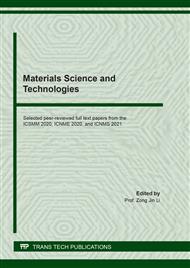[1]
Onnes H. K. (1911). Further experiments with liquid helium. C. On the change of electric resistance of pure metals at very low temperatures etc. IV. The resistance of pure mercury at helium temperatures., Proceedings of the Section of Sciences. 13: 1274–1276.
DOI: 10.1007/978-94-009-2079-8_15
Google Scholar
[2]
Meissner W., Ochsenfeld R. (1933). Ein neuer Effekt bei Eintritt der Supraleitfähigkeit., Naturwissenschaften. 21 (44): 787-788.
DOI: 10.1007/bf01504252
Google Scholar
[3]
Bardeen J., Cooper L., Schrieffer J. R. (December 1, 1957). Theory of Superconductivity. Physical Review. 108.
Google Scholar
[4]
Daintith J. (2009). The Facts on File Dictionary of Physics (4th ed.).
Google Scholar
[5]
Gallop J. C. (1990). SQUIDS, the Josephson Effects and Superconducting Electronics.
Google Scholar
[6]
Durrant, A. (2000). Quantum Physics of Matter. CRC.
Google Scholar
[7]
Tinkham, Michael (1996). Introduction to Superconductivity.
Google Scholar
[8]
Bardeen J., Cooper L. N. and Schrieffer J. R. (1957). Theory of Superconductivity., Physical Review. 108 (5): 1175–1205.
Google Scholar
[9]
Steglich, F., Aarts, J., Bredl, C. D., Lieke, W., Meschede, D., Franz, W., Schäfer, H. (1979). Superconductivity in the Presence of Strong Pauli Paramagnetism: CeCu2Si2., Physical Review Letters. 43 (25): 1892–1896.
DOI: 10.1007/978-94-011-1622-0_6
Google Scholar
[10]
P. Dai, B. C. Chakoumakos, G. F. Sun, K. W. Wong, Y. Xin and D. F. Lu (1995). Synthesis and neutron powder diffraction study of the superconductor HgBa2Ca2Cu3O8+δ by Tl substitution., Physica C. 243 (3–4): 201–206.
DOI: 10.1016/0921-4534(94)02461-8
Google Scholar
[11]
Gao L., Xue Y. Y., Chen F., Xiong Q., Meng R. L., Ramirez D., Chu C. W., Eggert J. H., Mao H. K. (1994). Superconductivity up to 164 K in HgBa2Cam-1CumO2m+2+δ (m=1, 2, and 3) under quasihydrostatic pressures., Phys. Rev. B. 50 (6): 4260–4263.
DOI: 10.1016/0921-4534(94)91971-2
Google Scholar
[12]
Jin J. X. Principle of High-Temperature Superconducting Technologies and Applications.
Google Scholar
[13]
Ro Lee E., Lee S., Lee Ch., Jun Suh H. Test of DC reactor type fault-current limiter using magnet for optimal design.,.
DOI: 10.1109/tasc.2002.1018534
Google Scholar
[14]
Firouzi M. a,⇑, Gharehpetian G. B.,b Mozafari B. (2014), Bridge-type superconducting fault current-limiter effect on distance relay characteristics,, Electrical Power and Energy Systems 68 (2015) 115–122.
DOI: 10.1016/j.ijepes.2014.12.061
Google Scholar


